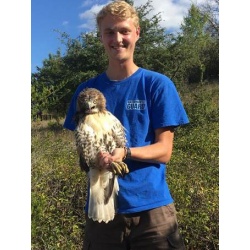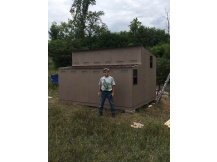
Luther College and Raptor Resource Project build banding station
Thanks to a grant from the Iowa DNR, Luther College and the Decorah Raptor Resource Project have built an autumn migration banding station on campus, giving students unprecedented direct access to wildlife and conservation research.
The banding station, located on Hawk Hill on the northeast edge of the Luther campus, is large enough for classes to observe wild birds, band them and gather data before releasing them back into the wild.
"The awe of being up close and personal with wildlife is a unique and rare opportunity," said Luther College Center for Sustainable Communities assistant director Emily Neal, adding, "Holding a bird in your hand and feeling something that's so free and powerful, yet at the same time fragile in a world where humans have such an impact on our environment is an amazing experience."
Neal worked with Dave Kester and Amy Ries from the Raptor Resource Project on a grant to build the blind. "This partnership strengthens the connections between academia and the work of non-profit conservation," said Kester. "We dovetail each other's mission statements," Kester added.
As part of the partnership, RRP hired six Luther College students as interns for the fall semester to learn field and research techniques for trapping and banding wild hawks.
"While this is a new wildlife research opportunity for students, Luther has a great history of providing students wildlife research opportunities here on campus, that also includes bats and insect studies," said Neal. "Science at Luther isn't just happening between four walls of a classroom, but also out in the field with birds overhead."
For more information and for opportunities to view the blind, contact Emily Neal, nealem01@luther.edu or (563) 387-2138.
Site designed and maintained by Iroc Web Design Services©.
Your Small Business Web Design Solutions.™



